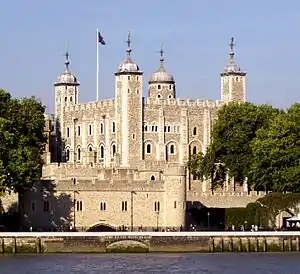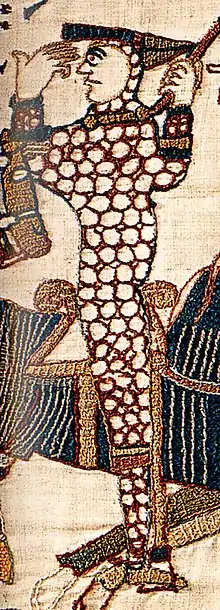1080s in England
| Other decades |
| 1060s | 1070s | 1080s | 1090s | 1100s |
Events from the 1080s in England.
Incumbents
- Monarch – William I (to 9 September 1087), William II
Events
- 1080
- 14 May – William Walcher, Bishop of Durham, is killed by rebel Northumbrians; King William I sends his half-brother Odo of Bayeux to pacify Northumbria.[1]
- Autumn – William's son Robert Curthose sent to invade Scotland; reaches as far as Falkirk.[1]
- Robert Curthose builds a castle on the River Tyne; now Newcastle upon Tyne.[2]
- Osmund (bishop of Salisbury), builds Devizes Castle.
- Gundulf of Rochester begins building of Rochester Cathedral.[3]
- William I, in a letter, refuses to accept Pope Gregory VII as his overlord.[2]
- 1081
- William campaigns in Wales, reaching as far as St David's.[2]
- Construction of Ely Cathedral begins.[2]
- 1082
- Odo of Bayeux arrested, and forfeits his Earldom and estates.[2]
- Bayeux Tapestry completed.[2]
- 1083
- 1084
- Construction of Worcester Cathedral begins.[2]
- 1085
- Threatened invasion from Denmark aborted after a rebellion there.[2]
- 25 December – William commissions the Domesday Book.[1]
- 1086
- 1087
- 9 September – William I of England (William the Conqueror) dies at Rouen while on campaign in northern France; his first son Robert succeeds him as Robert II, Duke of Normandy whilst his second son succeeds him on the English throne as William II of England.[1]
- 26 September – coronation of William II at Westminster Abbey.[1]
- 25 December – Odo of Bayeux re-instated as Earl of Kent.[2]
- An early fire of London destroys much of the city including St Paul's Cathedral.[5]
- 1088
- April – Odo of Bayeux leads the Rebellion of 1088 against his nephew William II.[1] The church of Gloucester Abbey is among the places laid waste in the rebellion.
- July – William defeats the rebels, and exiles Odo to Normandy.[2]
- Construction of the White Tower of the Tower of London probably largely completed.[2]
- 1089
- May – See of Canterbury left vacant after the death of Lanfranc.[2]
- Construction begins on Gloucester Cathedral and Tewkesbury Abbey.[2]
Births
- 1080
- Adelard of Bath, scholar (died c. 1152)
- Aubrey de Vere II, Lord Great Chamberlain (died 1141)
- Henry of Huntingdon, historian (died 1160)
- 1083
- Gilbert of Sempringham, founder of the Gilbertine Order (died c. 1190)
Deaths
- 1080
- 14 May – William Walcher, Bishop of Durham
- 1083
- 2 November – Matilda of Flanders, wife of King William I of England (born c. 1031, France)
- 1085
- 27 March – Walter de Lacy, Norman noble
- 1087
- 9 September – William I of England (born c. 1028, Normandy)
- 1088
- 1089
- 24 May – Lanfranc, Archbishop of Canterbury (born c. 1005, Lombardy)
References
- Williams, Hywel (2005). Cassell's Chronology of World History. London: Weidenfeld & Nicolson. pp. 113–114. ISBN 0-304-35730-8.
- Palmer, Alan; Palmer, Veronica (1992). The Chronology of British History. London: Century Ltd. pp. 55–56. ISBN 0-7126-5616-2.
- "Rochester Cathedral website". Retrieved 22 December 2007.
- "Time traveller's guide to Medieval Britain". Archived from the original on 3 December 2007. Retrieved 2007-12-22.
- Weinreb, Ben; Hibbert, Christopher (1995). The London Encyclopaedia. Macmillan. p. 287. ISBN 0-333-57688-8.
This article is issued from Wikipedia. The text is licensed under Creative Commons - Attribution - Sharealike. Additional terms may apply for the media files.

